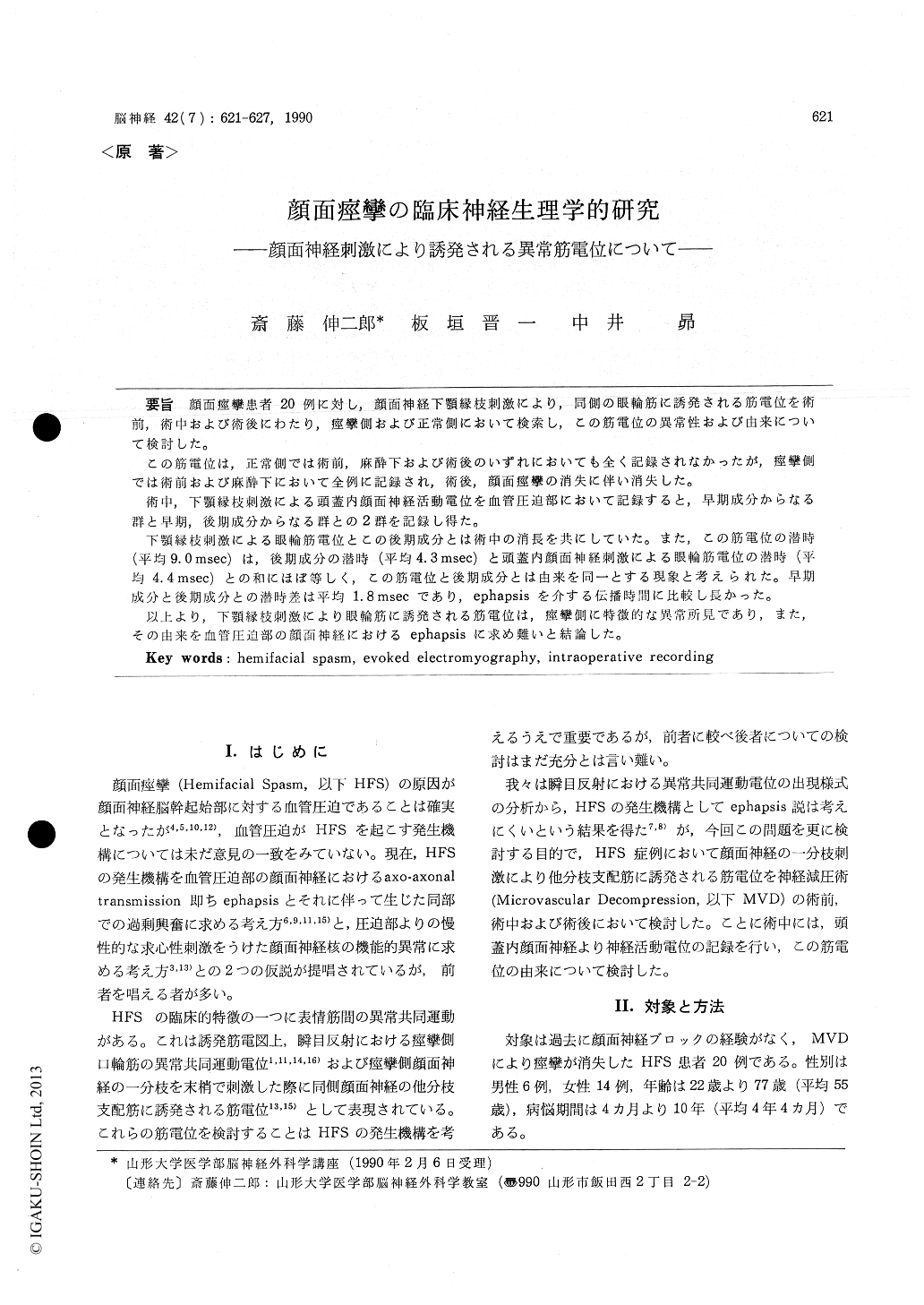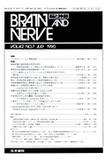Japanese
English
- 有料閲覧
- Abstract 文献概要
- 1ページ目 Look Inside
顔面痙攣患者20例に対し,顔面神経下顎縁枝刺激により,同側の眼輪筋に誘発される筋電位を術前,術中および術後にわたり,痙攣側および正常側において検索し,この筋電位の異常性および由来について検討した。
この筋電位は,正常側では術前,麻酔下および術後のいずれにおいても全く記録されなかったが,痙攣側では術前および麻酔下において全例に記録され,術後,顔面痙攣の消失に伴い消失した。
術中,下顎縁枝刺激による頭蓋内顔面神経活動電位を血管圧迫部において記録すると,早期成分からなる群と早期,後期成分からなる群との2群を記録し得た。
下顎縁枝刺激による眼輪筋電位とこの後期成分とは術中の消長を共にしていた。また,この筋電位の潜時(平均9.Omsec)は,後期成分の潜時(平均4.3msec)と頭蓋内顔面神経刺激による眼輪筋電位の潜時(平均4.4msec)との和にほぼ等しく,この筋電位と後期成分とは由来を同一とする現象と考えられた。早期成分と後期成分との潜時差は平均1.8msecであり,ephapsisを介する伝播時間に比較し長かった。
以上より,下顎縁枝刺激により眼輪筋に誘発される筋電位は,痙攣側に特徴的な異常所見であり,また,その由来を血管圧迫部の顔面神経におけるephapsisに求め難いと結論した。
Electromyographic responses (MD-OC) of the orbicularis oculi muscle to stimulation of ipsilateral marginal mandibular branch of the facial nerve were recorded in 20 patients with hemifacial spasm,pre-, post-operatively and during operations to relieve it by microvascular decompression, and the abnormal features and origin of the MD-OC were investigated.
On the affected side, the MD-OC were recorded in pre- and during operative state, and disap-peared with disappearnce of hemifacial spasm after microvascular decompression, while no response was recorded in pre-, during and post-operative state on the healthy side.
In 17 patients, the MD-OC was recorded con-tinuously during operation. In all cases except for one case in whom the MD-OC was recorded even the end of operation, the MD-OC disappeared on several stage of procedure from dural opening through vascular mobilization.
The compound nerve action potential (MD-VII) to stimulation of the marginal mandibular branch was recorded from the facial nerve near its root entry zone after exposure of the intracranial por-tion. There were two patterns in the records, i. e., one group consisting of early component and the other consisting of early and late component. The MD-VIE was only consisted of the early com-ponent in 12 cases in whom the MD-OC have already disappeared, and was consisted of the early and late component in 5 cases in whom the MD-OC still recorded. And in 2 cases of the later, the late component disappeared simultane-ously with disappearance of the MD-OC during vascular mobilization. In addition, the latency of the MD-OC (mean latency : 9.0 msec) was nearly equal to the sum of the latency of the response of orbicularis oculi muscle to stimulation of the facial nerve near its root exit zone (mean : 4.4 msec) and the latency of the late component of the MD-VII (mean : 4.3 msec).
These results suggest that the MD-OC and the late component of the MD-VII may have the same origin. The latency differnece (mean : 1.8 msec) of the late and early component of the MD-VII was longer than transmission time via ephapsis.
In conclusion, the MD-OC is abnormal finding characteristic of the affected side and is not likely to originate from ephapsis in the facial nerve at the site of vascular compression.

Copyright © 1990, Igaku-Shoin Ltd. All rights reserved.


